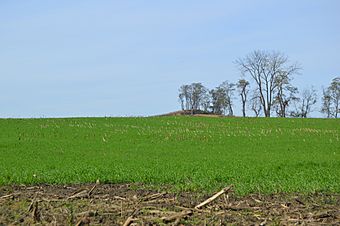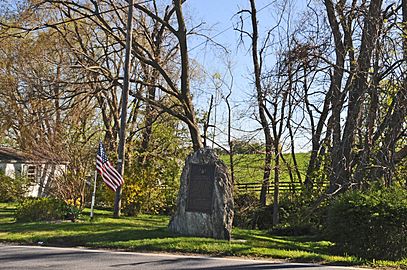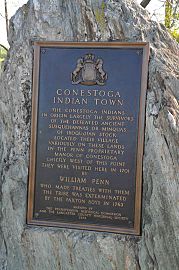Conestoga Town facts for kids
Quick facts for kids |
|
|
Conestoga Town
|
|

Overview from Safe Harbor Road
|
|
| Location | Junction of Safe Harbor and Indian Marker Roads, Manor Township, Pennsylvania |
|---|---|
| Area | 5 acres (2.0 ha) |
| Built | c. 1690 |
| NRHP reference No. | 73001636 |
| Added to NRHP | June 18, 1973 |
Conestoga Town is a special historical place in Manor Township, Lancaster County, Pennsylvania. It's an archaeological site, which means it's a place where scientists study old things to learn about the past. This site was once a village for the Native American people known as the Susquehannock. They lived here from the late 1600s to the mid-1700s.
Contents
Discovering Conestoga Town's Past
Conestoga Town was one of the earliest known villages of the Susquehannock people. Their land was very large, stretching from northern Maryland up through southern New York. It covered the entire area around the Susquehanna River, which is named after them.
Who Were the Susquehannock People?
For most of the 1600s, the Susquehannock were a strong and important Native American group. They were also called the Conestogas. Their name, "Conestoga," means "Buried Pole Place" or "town." This name is similar to words in other Iroquois languages.
Life in the Village
Scientists have dug at the site and found clues about how people lived. They discovered remains of structures that looked like log cabins. They also found cemeteries, showing where the villagers were buried. The village was used from the 1690s until about 1725. Even after the Susquehannock nation faced challenges in the 1670s, this village continued. Over time, the village moved to different spots within a large area.
Important Meetings and Early Neighbors
Conestoga Town was a key meeting place. Different Native American tribes would gather here. Important government officials from Pennsylvania also came to meet with tribal leaders. One famous visitor was William Penn, who founded Pennsylvania. He came to talk and make agreements with the Susquehannock leaders.
In the early 1700s, many European settlers moved near Conestoga Town. These neighbors included English, Scotch-Irish, and German-Swiss families. They lived on both sides of the Conestoga River. These early settlers played a role in creating Lancaster County in 1728.
A Later Chapter
The original Conestoga Town site was very important. Later, in 1763, another village of the Conestoga people was attacked by a group called the Paxton Boys.
Conestoga Town was recognized for its historical importance in 1973. It was added to the National Register of Historic Places. This list includes places that are very important to the history of the United States.





